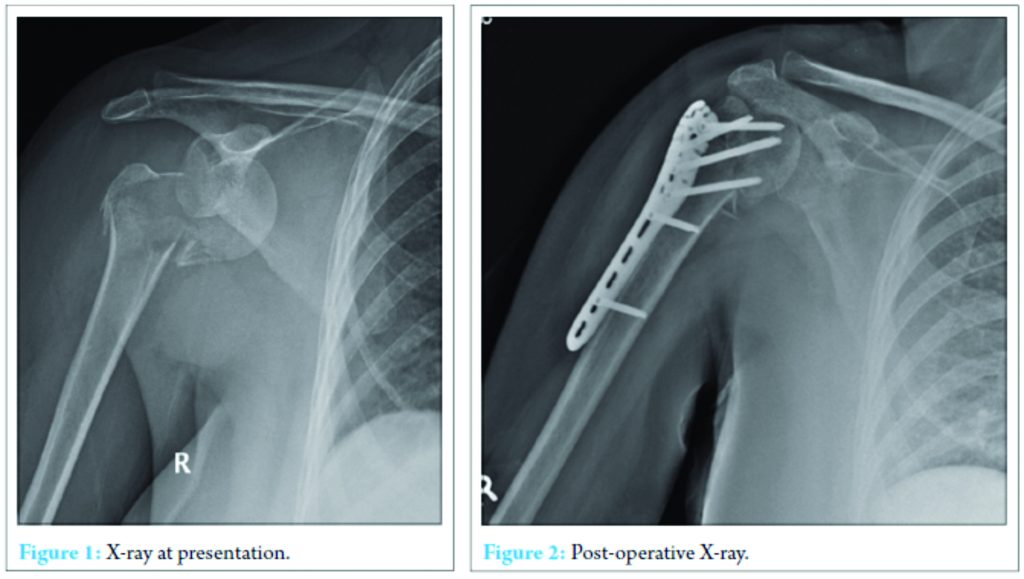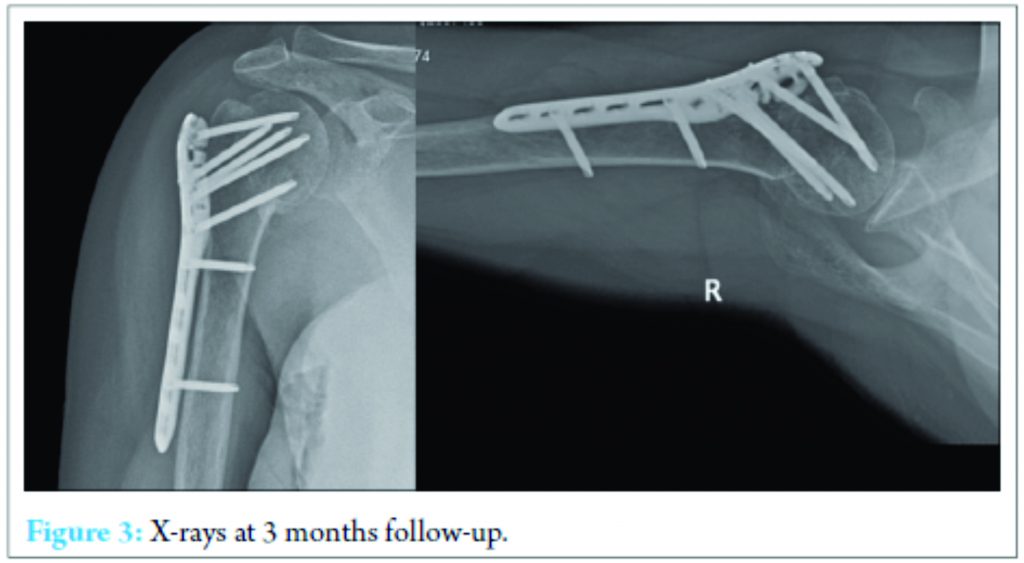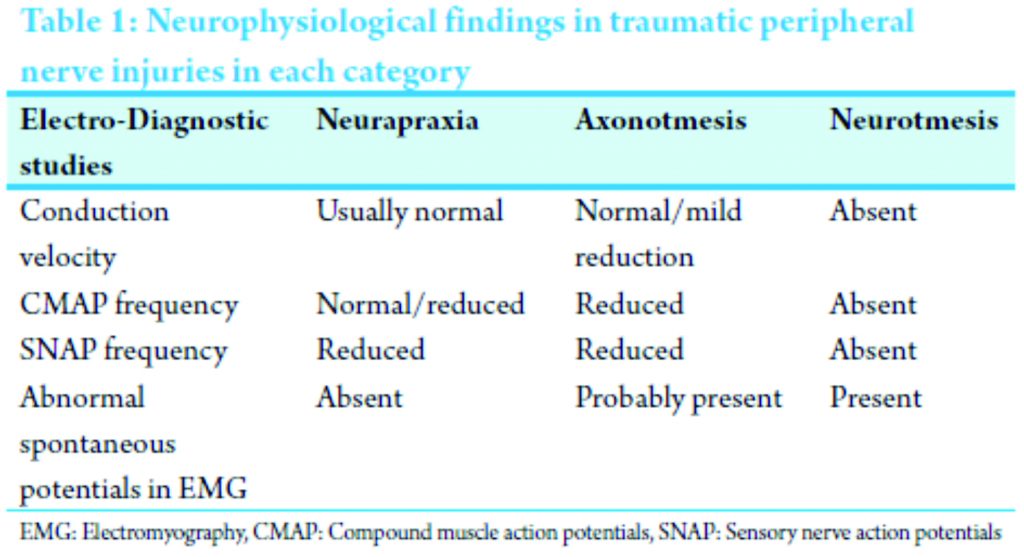[box type=”bio”] What to Learn from this Article?[/box]
In shoulder fracture dislocations, neurological deficit may be masked by pain and loss of motion due to fracture. Detailed clinical examination is required and electrodiagnostic studies are indicated in suspected cases. This article reviews the diagnostic algorithm and management options in such cases.
Case Report | Volume 7 | Issue 2 | JOCR March – April 2017 | Page 48-51| Sameer Rathore, Srinivas Kasha, Srinivas Yeggana. DOI: 10.13107/jocr.2250-0685.746
Authors: Sameer Rathore[1], Srinivas Kasha[1], Srinivas Yeggana[1]
[1] Department of Orthopaedics, Krishna Institute of Medical Sciences, Secunderabad, Telengana, India.
Address of Correspondence
Dr. Sameer Rathore,
Department of Orthopaedics, Krishna Institute of Medical Sciences, Secunderabad, Telengana, India.
E-mail: dr.sameer.rathore@gmail.com
Abstract
Introduction: Injuries causing fracture dislocation of shoulder and brachial plexus palsy are extremely rare. As per authors’ knowledge, three part fracture of proximal humerus with shoulder dislocation and brachial plexus palsy has not been reported in the literature.
Case presentation: A 53 year old female sustained a three part fracture of right proximal humerus along with dislocation of shoulder joint and brachial plexus palsy following a fall from a flight of stairs. Fracture was managed by plating of proximal humerus and brachial palsy was followed up with electrodiagnostic studies and regular physiotherapy. Fracture united by three months and patient had near complete recovery of brachial palsy. Authors have discussed diagnostic modalities and management options in the article.
Conclusion: Clinician should always look for clinical evidence of brachial plexus injury in patients with anterior shoulder dislocation. Signs of nerve injury with shoulder fracture dislocation are easily overlooked or incorrectly attributed to pain due to bony injury. Subsequent loss of shoulder function in elderly is often thought to be due to immobilization and stiffness. Clinical suspicion can help in diagnosing the often missed neurological injuries and can help in improving outcomes.
Keywords: Brachial plexus palsy, diagnosis of brachial plexus injury, nerve injury with shoulder dislocation, shoulder fracture dislocation.
Introduction
Post-traumatic anterior fracture dislocation of shoulder is the most common type of fracture dislocation caused by excessive hyperextension and external rotation of the arm in overhead direction [1]. As the humeral head is levered out of the glenoid, the anterior post-traumatic dislocation of the shoulder can be associated with fracture of the glenoid (i.e., bony Bankart); seldom can it be associated with the impaction fracture of the humeral head or of the greater tuberosity [2]. Furthermore, anterior shoulder dislocation may be associated with rotator cuff tears, especially in elderly patients [3]. Neurological injuries are associated with anterior dislocation of shoulder, of which axillary nerve is the most common with an incidence of 9-10% [1]. In contrast, brachial plexus injury is rare and complicated, and very few cases have been reported in the literature [4]. Patient evaluation consists of focused assessment of upper extremity sensory and motor function, radiological studies, and most importantly, electrodiagnostic studies. Conservative management is usually successful, and recovery takes place after several months [5, 6, 7]. We report a unique case of anterior dislocation of the shoulder with associated three-part fracture of proximal humerus and brachial plexus palsy.
Case Report
A 53-year-old right-handed female had a history of fall from a flight of stairs on her right arm which was in abduction and external rotation at the time of injury. After the injury, she was unable to move her arm. Clinical examination showed an asymmetric profile of right shoulder with pain and neurological deficit in the right upper limb. Sensations were reduced on lateral aspect of arm, dorsal, and ulnar aspect of forearm and both volar and dorsal aspect of wrist and hand. Motor deficit was seen involving the extensors of wrist and fingers. Other motor deficits could not be evaluated at this stage due to fracture dislocation of shoulder and were examined after reduction and fixation. Clinically, it was diagnosed to be brachial plexus injury involving posterior and medial cords. X-ray showed three-part fracture dislocation of right shoulder (Fig. 1).
Open reduction and internal fixation of proximal humerus were done after pre-anaesthetic evaluation (Fig. 2 and 3). Exploration of nerve lesion was not attempted during fracture fixation surgery as injury was closed and according to the mechanism of injury, it was presumed to be probably neuropraxia/axonotmesis. Detailed motor examination was done after 3 days once the patient was comfortable. Power of shoulder abduction was found to be 2/5, elbow extension was 0/5, flexion was 4/5, wrist extension and finger extension was 0/5, wrist and finger flexion was 0/5, adduction and abduction of fingers was 0/5, and thumb abduction and extension was 0.5 as per the Medical Research Council scale. Forward flexion of shoulder and rotations was intact. Electromyography (EMG) and nerve conduction velocity test (NCV) were performed after 3 weeks.  It showed infraclavicular brachial plexus palsy with denervation of extensor of elbow, wrist, and fingers and flexors of wrist. Conservative treatment in the form of physiotherapy, stretching of muscles to prevent contractures, and strengthening of functional muscles were followed. Sensory reeducation, dynamic cock up splinting, electrical stimulation twice a day, and range of motion exercises were continued. At follow up of 6 months, median and radial nerve function were found to be improving. Power improved in supinator, flexors, and extensors of wrist and fingers. By 12 months, there was further improvement in motor power. Abduction of shoulder was 4/5, with range of 0-130 degrees, triceps power was 5/5, wrist and finger extension and flexion power being 4/5, adduction and abduction of fingers was 3/5, and thumb abduction and extension was 3.5. At follow-up of 18 months, the patient regained near-normal power of the limb with complete recovery of shoulder abduction; elbow, wrist, and finger extension and flexion. Only adduction and abduction power of fingers, abduction and extension of thumb was limited to 3/5. Functionally, the patient has reduced dexterity of hand but is able to manage routine activities.
It showed infraclavicular brachial plexus palsy with denervation of extensor of elbow, wrist, and fingers and flexors of wrist. Conservative treatment in the form of physiotherapy, stretching of muscles to prevent contractures, and strengthening of functional muscles were followed. Sensory reeducation, dynamic cock up splinting, electrical stimulation twice a day, and range of motion exercises were continued. At follow up of 6 months, median and radial nerve function were found to be improving. Power improved in supinator, flexors, and extensors of wrist and fingers. By 12 months, there was further improvement in motor power. Abduction of shoulder was 4/5, with range of 0-130 degrees, triceps power was 5/5, wrist and finger extension and flexion power being 4/5, adduction and abduction of fingers was 3/5, and thumb abduction and extension was 3.5. At follow-up of 18 months, the patient regained near-normal power of the limb with complete recovery of shoulder abduction; elbow, wrist, and finger extension and flexion. Only adduction and abduction power of fingers, abduction and extension of thumb was limited to 3/5. Functionally, the patient has reduced dexterity of hand but is able to manage routine activities.
Discussion
Neurological lesions along with shoulder dislocation or fracture dislocation are an underreported entity. Usually, loss of movements is attributed to bony injury and pain. A report by Liveson [8] showed nerve damage not previously reported in 11 patients with shoulder dislocation by electrodiagnostic examination studies. Lesions can be situated at any level of brachial plexus in axillary region from base of nerve root to the division. Most commonly, lesions are postganglionic, infraclavicular, and occur in continuity [9]. With anterior shoulder dislocation, most common neurological lesion is of infraclavicular brachial plexus with axillary nerve [2, 10, 11, 12, 13, 14, 15]. Travlos et al. [16] reviewed 28 patients of shoulder dislocation leading to brachial plexus lesion and found both supraclavicular and infraclavicular lesions. In supraclavicular lesions, suprascapular nerve is most commonly involved and always recovered spontaneously. The mechanism of brachial plexus injury is diverse. Injury could be due to stretching at the time of trauma, compression by hematoma, and/or direct trauma by the humeral head. Entrapment of nerves during reduction of the dislocation is also possible. The most common injury is neuropraxia due to traction as nerves are stretched over the dislocated humeral head. Low-velocity trauma can lead to nerve injury with shoulder dislocation because the distance between the anchorage points of nerves in upper limb is short, making nerves vulnerable to traction [15]. In the presented case, it was low-velocity trauma leading to fracture dislocation and brachial plexus injury. The site of nerve injury has been related to arm position during dislocation [17]. A fall with the arm in full abduction and external rotation causes major tension on all cords. Extension of the elbow and wrist distracts the medial cord; with the elbow flexed, the posterior and medial cords are under tension. Diagnosis of brachial plexus injury is easy to miss as symptoms may be masked by pain due to bony injury or massive rotator cuff tear. Clinical suspicion is required, and in doubtful cases EMG and NCV must be done at 3-4 weeks post injury [15, 18, 19]. At 3-4 weeks, conduction of potentials stop along a nerve due to Wallerian degeneration and denervation changes (fibrillation potentials) can be seen as early as 10-14 days after injury in proximal muscles and as late as 3-6 weeks in distal muscles. EMG tells the grade and phase of denervation or ongoing reinnervation of particular muscle group and thus indicates indirectly which part of plexus is involved. In posttraumatic brachial plexus injuries, the amplitude of compound muscle action potentials (CMAP) is generally low and is related to the total amount of functional muscle fibers. Sensory nerve action potentials (SNAP) are very important in localizing a lesion as preganglionic or postganglionic. SNAPs will be preserved in lesions proximal to the dorsal root ganglia, due to the fact that the sensory nerve cell bodies are intact within the dorsal root ganglion. Hence, in preganglionic injuries, there are normal SNAPs in an otherwise insensate dermatome and CMAPs are absent. SNAPs will be absent in a postganglionic or combined pre- and post-ganglionic lesion [18, 19] (Table 1). In the presented case, EMG at 3 weeks showed denervation of extensors of elbow, wrist, and fingers and flexors of wrist. CMAP in these muscle groups was reduced. Conduction velocity was slightly reduced and SNAPs were decreased. Hence, the lesion was considered to be a post-ganglionic lesion of brachial plexus involving the posterior and medial cords with nerve in continuity. The diagnostic benefits of EMG/nerve conduction studies are related to the experience and the capability of clinician to interpret the results of these tests. Early signs of muscle recovery may be detected on EMG (occurrence of nascent potentials, decreased number of fibrillation potentials, appearance of or an increased number of motor unit potentials). These signs contribute to expected clinical recovery in weeks or months. However, EMG recovery does not always ensure relevant clinical recovery. In addition, EMG evidence of ongoing reinnervation may not be detected in lesions where target end organs are more distal [19]. Magnetic resonance imaging or computed tomography myelography may be performed to assess anatomic continuity and site of lesion. Appropriate time is 3-4 weeks after trauma to assure that there is enough time for blood clots to be absorbed and for the formation of pseudomeningocele which is an indicative sign of root avulsion injury [18, 19]. If the investigations are suggestive of neuropraxia, usual treatment strategy is conservative. Physiotherapy has a very important function in maintaining mobility until motor function returns. A program of hand, wrist, and elbow mobilization should be started. Signs of recovery may start appearing by 3 months and good recovery has been seen with conservative management in up to 18 months [3, 4, 5, 6, 7, 8, 9, 10, 11, 12, 13, 14, 15, 16, 17, 18, 19]. It is important to note that signs of neuropraxia and neurotmesis are similar until the neuropraxia wears off and, therefore, it is better to wait for 3-6 months before considering exploration. To wait longer than 9 months is disadvantageous since the results of nerve repair after this period are not good [18, 19, 20, 21, 22, 23]. Alnot [24] reviewed 420 adults of traumatic brachial plexus palsy treated with surgery and presented decision criteria for neurolysis and/or nerve grafting. When the nerve lesion is in continuity, neurolysis may help. As exploration is usually delayed, neurorrhaphy is seldom possible. Nerve grafting is the predominant technique for clear cut injuries with a healthy proximal stump and with no axial damage. The outcome is influenced by the length of the nerve graft, the presence of scar tissue at the wound site, the number of grafts used, the presence of a healthy proximal stump available for grafting, and the nerve gap to be covered [20, 21]. The sural nerve, the sensory branch of ulnar nerve, and the medial cutaneous nerve of the forearm are the usual donor nerves. This procedure is the basis of the current surgical treatment of postganglionic spinal nerve injury. When damage is extensive, prioritization of certain nerves for repair by grafting is necessary, especially those associated with elbow flexion, shoulder abduction and sensation of the forearm. Neurotization procedure is generally used for preganglionic root injury. Neurofibers are transferred to an irreparable paralytic. Motor branches are used as donors aiming to achieve motor reinnervation. The nerve transfer may be extraplexus or intraplexus. Intraplexus transfer options include intact nerve roots, medial pectoral nerve, and inferior medial cord/ulnar nerve. Extraplexus transfer options include the use of intercostal nerve, spinal accessory nerve, and phrenic nerve [19]. The presented case had infraclavicular brachial plexus injury with fracture dislocation involving both medial and radial nerve. It was managed conservatively and recovery started with median nerve first. Return to previous range of motion and strength of upper limb took similar time as reported in previously published reports.
Conclusion
Clinician should always look for clinical evidence of brachial plexus injury in patients with anterior shoulder dislocation. In elderly patients, signs of nerve injury with shoulder dislocation are easily overlooked and subsequent loss of shoulder function in elderly is often thought to be due to immobilization and stiffness. Early detection of nerve lesions allows for adequate treatment. If lesion is in continuity, which it most often is, good recovery can be expected in due course of time if proper physiotherapy is instituted.
Clinical Message
Clinical suspicion and detailed examination are required to ascertain neurological deficit in a patient with shoulder fracture dislocation. In suspected cases, EMG and NCV should be done at 3-4 weeks to delineate nerve injuries. Most commonly, the injury is in continuity, which recovers with time. The patient should be counseled regarding a long recovery period and some residual deficit. During this period, proper physiotherapy should be instituted to maintain mobility of joints and prevent contractures. In rare cases, where expected recovery is not seen, the patient should be investigated for further to look for neurotemesis.
References
1. Neviaser RJ, Neviaser TJ, Neviaser JS. Concurrent rupture of the rotator cuff and anterior dislocation of the shoulder in the older patient. J Bone Joint Surg Am 1988;70(9):1308-1311.1. Neviaser RJ, Neviaser TJ, Neviaser JS. Concurrent rupture of the rotator cuff and anterior dislocation of the shoulder in the older patient. J Bone Joint Surg Am 1988;70(9):1308-1311.
2. Zarins B, McMahon MS, Rowe CR. Diagnosis and treatment of traumatic anterior instability of the shoulder. Clin Orthop Relat Res 1993;291:75-84.
3. Simonich SD, Wright TW. Terrible triad of the shoulder. J Shoulder Elbow Surg 2003;12(6):566-568.
4. Johnson JR, Bavley JI. Early complication of acute anterior dislocation of the shoulder in the middle aged and elderly patients. Injury 1982;13(5):431-434.
5. Shears E, Sunderamoorthy D, Ali SA. Brachial plexus injury after anterior shoulder dislocation: A case report. Acta Orthop Belg 2005;71(4):489-490.
6. Shin AY, Spinner RJ, Steinmann SP, Bishop AT. Adult traumatic brachial plexus injuries. J Am Acad Orthop Surg 2005;13(6):382-396.
7. Yip KM, Hung LK, Maffulli N, Chan KM. Brachial plexus injury in association with fracture-dislocation of the shoulder. Bull Hosp Jt Dis 1996;55(2):92-94.
8. Liveson JA. Nerve lesions associated with shoulder dislocation; an electrodiagnostic study of 11 cases. J Neurol Neurosurg Psychiatry 1984;47(7):742-744.
9. Wipatayi BP, Finalyson A, Weliman CJ, Hemilton MJ, Abbas M, Sieunarine KK. Axillary artery and brachial plexus injuries due to anterior shoulder dislocation. Eur Trauma 2005;31:181-185.
10. Kosiyatrakul A, Jitprapaikulsarn S, Durand S, Oberlin C. Recovery of brachial plexus injury after shoulder dislocation. Injury 2009;40(12):1327-1329.
11. Berbig R, Weishaupt D, Prim J, Shahin O. Primary anterior shoulder dislocation and rotator cuff tears. J Shoulder Elbow Surg 1999;8(3):220-225.
12. Groh GI, Rockwood CA Jr. The terrible triad: Anterior dislocation of the shoulder associated with rupture of the rotator cuff and injury to the brachial plexus. J Shoulder Elbow Surg 1995;4:51-53.
13. Güven O, Akbar Z, Yalçin S, Gündes H. Concomitant rotator cuff tear and brachial plexus injury in association with anterior shoulder dislocation: Unhappy triad of the shoulder. J Orthop Trauma 1994;8(5):429-430.
14. Goubier JN, Duranthon LD, Vandenbussche E, Kakkar R, Augereau B. Anterior dislocation of the shoulder with rotator cuff injury and brachial plexus palsy: A case report. J Shoulder Elbow Surg 2004;13(3):362-363.
15. Visser CP, Coene LN, Brand R, Tavy DL. The incidence of nerve injury in anterior dislocation of the shoulder and its influence on functional recovery. A prospective clinical and EMG study. J Bone Joint Surg Br 1999;81(4):679-685.
16. Travlos J, Goldberg I, Boome RS. Brachial plexus lesions associated with dislocated shoulders. J Bone Joint Surg Br 1990;72(1):68-71.
17. Kleinrensink GJ. Influence of Posture and Motion on peripheral Nerve Tension. Rotterdam: Thesis; 1997.
18. Gregory J, Cowey A, Jones M, Pickard S, Ford D. The anatomy, investigations and management of adult brachial plexus injuries. Orthop Trauma 2009;23(6):420-432.
19. Sakellariou VI, Badilas NK, Stavropoulos NA, Mazis G, Kotoulas HK, Kyriakopoulos S, et al. Treatment options for brachial plexus injuries. ISRN Orthop 2014;2014:10.
20. Bentolila V, Nizard R, Bizot P, Sedel L. Complete traumatic brachial plexus palsy. Treatment and outcome after repair. J Bone Joint Surg Am 1999;81(1):20-28.
21. Ruijs AC, Jaquet JB, Kalmijn S, Giele H, Hovius SE. Median and ulnar nerve injuries: A meta-analysis of predictors of motor and sensory recovery after modern microsurgical nerve repair. Plast Reconstr Surg 2005;116(2):484-494.
22. Korus L, Ross DC, Doherty CD, Miller TA. Nerve transfers and neurotization in peripheral nerve injury, from surgery to rehabilitation. J Neurol Neurosurg Psychiatry 2016;87(2):188-197.
23. Tu YK, Tsai YJ, Chang CH, Su FC, Hsiao CK, Tan JS. Surgical treatment for total root avulsion type brachial plexus injuries by neurotization: A prospective comparison study between total and hemicontralateral C7 nerve root transfer. Microsurgery 2014;34:91-101.
24. Alnot JY. Traumatic brachial plexus palsy in the adult. Retro – And infraclavicular lesions. Clin Orthop Relat Res 1988;237:9-16.
 |
 |
 |
| Dr. Srinivas Kasha | Dr. Sameer Rathore | Dr. Srinivas Yeggana |
| How to Cite This Article: Kasha S, Rathore S, Yeggana S. Fracture Dislocation of Shoulder with Brachial Plexus Palsy: A Case Report and Review of Management Options. Journal of Orthopaedic Case Reports 2017 Mar-Apr;7(2):48-51 |
[Full Text HTML] [Full Text PDF] [XML]
[rate_this_page]
Dear Reader, We are very excited about New Features in JOCR. Please do let us know what you think by Clicking on the Sliding “Feedback Form” button on the <<< left of the page or sending a mail to us at editor.jocr@gmail.com



